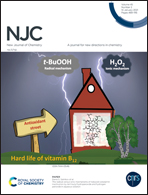Construction of a CsPbBr3 modified porous g-C3N4 photocatalyst for effective reduction of CO2 and mechanism exploration†
Abstract
In-depth research of the active sites and charge transport behavior is an important topic for investigating photocatalytic reduction of CO2. Herein, a novel photocatalyst composed of flake-like porous graphitic carbon nitride (P-CN) and CsPbBr3 is fabricated via a high temperature calcination and freeze drying method. The experimental results show that P-CN/CsPbBr3 has a superior CO2 reduction efficiency, and that the yield of CO reaches 30.39 μmol g−1, which is about 7.2 and 1.2 times higher than those of the primary B-CN (4.2 μmol g−1) and CsPbBr3 (24.4 μmol g−1), respectively. The improvement in photocatalytic performance is mainly ascribed to the heterostructure, which can promote the separation of photogenerated carriers, and the porous structure of P-CN, which can improve the absorption capacity of CO2. This study provides a significant method for the construction of efficient g-C3N4 based photocatalysts to reduce CO2.



 Please wait while we load your content...
Please wait while we load your content...